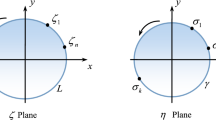The method of linear conjugation of analytical functions of complex variable was used to solve the problem of circular transversally isotropic plate bending hinged on the edge and loaded over the outer surface by the force distributed along the concentric curve. The complex potentials employed for registering the stress and deformation characteristics of the problem can possess the specific features at the concentrated force loading points, their nature was investigated and applied to the existing loading as conditionally concentrated. For getting the solution, the equation for the refined transtropic plate bending model was used that includes transverse shear strains and cross-sectional reductions, and, unlike other refined theories, the formulas with those refinements are advanced. The constants in the complex potentials were established with the boundary conditions and conjugation conditions for the moments and generalized angles of cross-section rotation along the loading line. With the approach by Timoshenko and Woinowsky-Krieger, from the circular loading solution, as a particular case, the solution for the centered concentrated force-loaded plate was obtained. For both cases, the refined normal radial and circumferential stresses were calculated in the center and on the edge of the plate. The data are summarized in tables and graphs. The model and numerical results show that an increase in the transverse plate anisotropy can radically change stress distribution patterns in its transverse cross-sections, up to the change in the radial stress signs on the outer surfaces. The classical model of plate bending and refined models such as by Timoshenko and Reissner are inapplicable in this case.

Similar content being viewed by others
References
N. I. Muskhelishvili, Some Basic Problems of the Mathematical Theory of Elasticity [in Russian], Nauka, Moscow (1966).
S. G. Lekhnitskii, Anisotropic Plates [in Russian], Gostekhizdat, Moscow (1957).
G. N. Savin, Stress Distribution Around Holes [in Russian], Naukova Dumka, Kiev (1968).
I. A. Prusov, Conjugation Method in the Theory of Plates [in Russian], BGU, Minsk (1975).
V. I. Shvabyuk, S. V. Rotko, and V. V. Shvabyuk, Mathematical Models of Deformation of Composite Plates and Beams: Contact Interaction with Dies and Substrates. Effect of Cracks [in Ukrainian], Vezha-Druk, Lutsk (2022).
V. I. Shvabyuk, S. V. Rotko, O. A. Uzhegova, and V. V. Shvabyuk, “Calculation of circular orthotropic plates by linear conjugation,” in: Resource-Saving Materials, Constructions, Buildings, and Structures [in Ukrainian], Issue 30, Rivne (2015), pp. 286–293.
V. I. Shvabyuk, “Complex representation of the refined bending equations for cracked orthotropic plates,” Mashynoznavstvo, No. 4, 51–55 (1999).
I. A. Prusov and L. I. Lunskaya, “Elastic state of piecewise-homogeneous orthotropic plane with cutouts,” Int Appl Mech, 5, No. 8, 845–850 (1969).
L. T. Berezhnitskii, M. V. Delyavskii, and V. V. Panasyuk, Bending of Thin Plates with Crack Defects [in Russian], Naukova Dumka, Kiev (1979).
L. P. Mazurak and L. G. Berezhnitskii, Bending of Transversally Isotropic Plates with Crack-Like Defects [in Russian], Naukova Dumka, Kiev (1990).
S. P. Timoshenko and S. Woinowsky-Krieger, Theory of Plates and Shells, McGraw-Hill, New York (1959).
S. Lukasiewicz, Local Loads in Plates and Shells, Kluwer Academic Publishers (1979).
S. B. Koval’chuk and A. V. Goryk, “Elasticity theory solution of the problem on bending of a narrow multilayer cantilever with a circular axis by loads at its end,” Mech Compos Mater, 54, No. 5, 605–620 (2018).
S. Rotko, V. Shvabyuk, O. Guda, and O. Uzhehova, “Specified calculation of steady-state oscillations of circular transtropy plates of medium thickness,” Mater Sci Forum, 968, 404–412 (2019).
V. I. Shvab’yuk, S. V. Rotko, Y. V. Fedorus’, and V. V. Shvab’yuk, “Influence of transverse anisotropy and type of boundary conditions on the stress state of a circular transtropic plate,” Strength Mater, 53, No. 3, 440–448 (2021). https://doi.org/10.1007/s11223-021-00304-z
Author information
Authors and Affiliations
Corresponding author
Additional information
Translated from Problemy Mitsnosti, No. 6, p. 70 – 80, November – December, 2023.
Rights and permissions
Springer Nature or its licensor (e.g. a society or other partner) holds exclusive rights to this article under a publishing agreement with the author(s) or other rightsholder(s); author self-archiving of the accepted manuscript version of this article is solely governed by the terms of such publishing agreement and applicable law.
About this article
Cite this article
Shvabyuk, V.I., Rotko, S.V., Shvabyuk, V.V. et al. Refined Calculation of a Circular Transtropic Plate Under Concentric Curve-Distributed Loading. Strength Mater (2024). https://doi.org/10.1007/s11223-024-00605-z
Received:
Published:
DOI: https://doi.org/10.1007/s11223-024-00605-z




